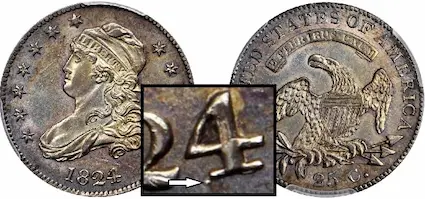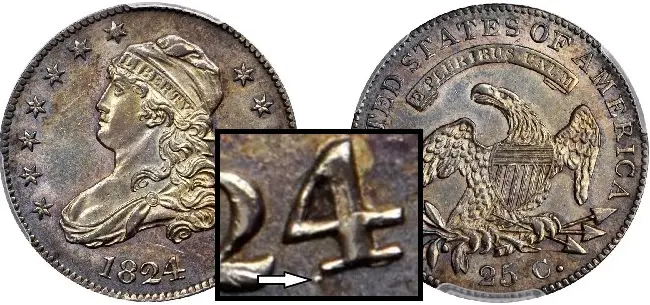1824 Capped Bust Quarter, 4/2
Designed by John Reich, the Capped Bust quarter first appeared in 1815. In the early years of the United States Mint, the number and type of gold and silver coins were struck according to the wishes of bullion depositors from the general public, and not by governmental orders.(1)
Throughout the 1790’s and early 1800’s, gold coins did not circulate well in the U.S. because gold was readily exported to Europe where it was valued higher. Large numbers of silver dollars were shipped to the West Indies because there they were overvalued in relation to the Spanish milled dollar. The Spanish dollars were then brought to America to exchange for U.S. dollars at par, and the cycle repeated itself. For these reasons, the production of silver dollars and $10 gold eagles was suspended in 1804.(2)
The half dollar suffered no exportation pressures and thus became the engine of the U.S. economy. Most bullion depositors arriving at the Mint’s front door preferred this denomination for its ease in facilitating business transactions. Consequently, quarter production was limited and intermittent until the 1830’s.(3)
There was no official mintage recorded for 1824 Capped Bust quarters, yet they do exist. Researcher Steve Tompkins dug through old documents and suggests the Mint’s delivery of 16,000 coins on December 31, 1823 to be the entire mintage of 1824 quarters. Owing to the small number of survivors (400), most experts believe this to be a reasonable conclusion.(4)
All 1824 quarters were struck from a single die pair, which married an unused 1822 obverse die overdated to read 1824 with the reverse die leftover from 1823. Therefore, all 1824 quarters feature the 4/2 overdate. The “2” digit is barely visible under the “4”.
The 1824/2 Capped Bust quarter is rare in all grades. Specialists who aspire to assemble a complete set of early quarters must have an example, and are willing to pay good money to reel one in.
As an entry in the Key Date Coin List of recommendations, the 1824/2 Capped Bust quarter obviously has a stellar record of price advancements over a period of many years. However, prices for most grades are off their peaks from the mid-2010’s, indicating now is a good time for bargain hunters in quest of this true rarity.
| Estimated survivors in all grades: 400 ?
The survivor estimate from PCGS represents an average of one or more experts' opinions as to how many examples survive of a particular coin in all grades. Survival estimates include coins that are raw, certified by PCGS, and certified by other grading services. Learn more at PCGS. |
| PCGS Rarity Scale: 6.2 ?
The 'PCGS CoinFacts Rarity Scale' assesses the relative rarity of all U.S. coins, based on estimated surviving examples. The scale runs from 1.0 to 10.0. The higher the number, the rarer the coin.
Learn more at PCGS. |
| Search for the 1824 Capped Bust Quarter, 4/2 on eBay** |
Preview of eBay selection:
 |
|
| Trendline Avg = 20.00 | BETTER |
 |
|
| Trendline Avg = 20.00 | BETTER |
Historic Value Trend Charts:
| Last updated 4-8-25 | Return to Key Date Coin List | |
| Compare to Common Date Coin of Same Type | ||
|
|
||
| Download Charts to Your Computer | ||
Sources
1. Stack's Bowers Galleries. 1824/2 Capped Bust Quarter. Feb 2019 Auction.
2. Bowers, Q. David. The History of United States Coinage. Los Angeles, CA: Bowers and Ruddy Galleries, Inc., 1979.
3. Stack's Bowers Galleries. 1824/2 Capped Bust Quarter. Feb 2019 Auction.
4. PCGS. 1824/2 25C (Regular Strike).
**Many very fine coin dealers sell on eBay. At any point in time, there may be over one million search results for United States coins. This includes quite a few of the recommendations on our Key Date Coin List.
If you’re thinking about purchasing a rare coin, eBay is certainly worth a look. For your convenience, the links from this site to eBay are coded to bring up only coins certified by PCGS and NGC.
As is always, always the case, never buy a valuable coin from a seller whose trustworthiness cannot be verified. Learn more about this at our chapter Best Places to Buy Coins, which also has a section on doing business on eBay.
In the interest of full disclosure, Rare Coins 101 receives a small commission anytime someone connects to eBay from this site and purchases something.
Coin images by Stack's Bowers Galleries.


